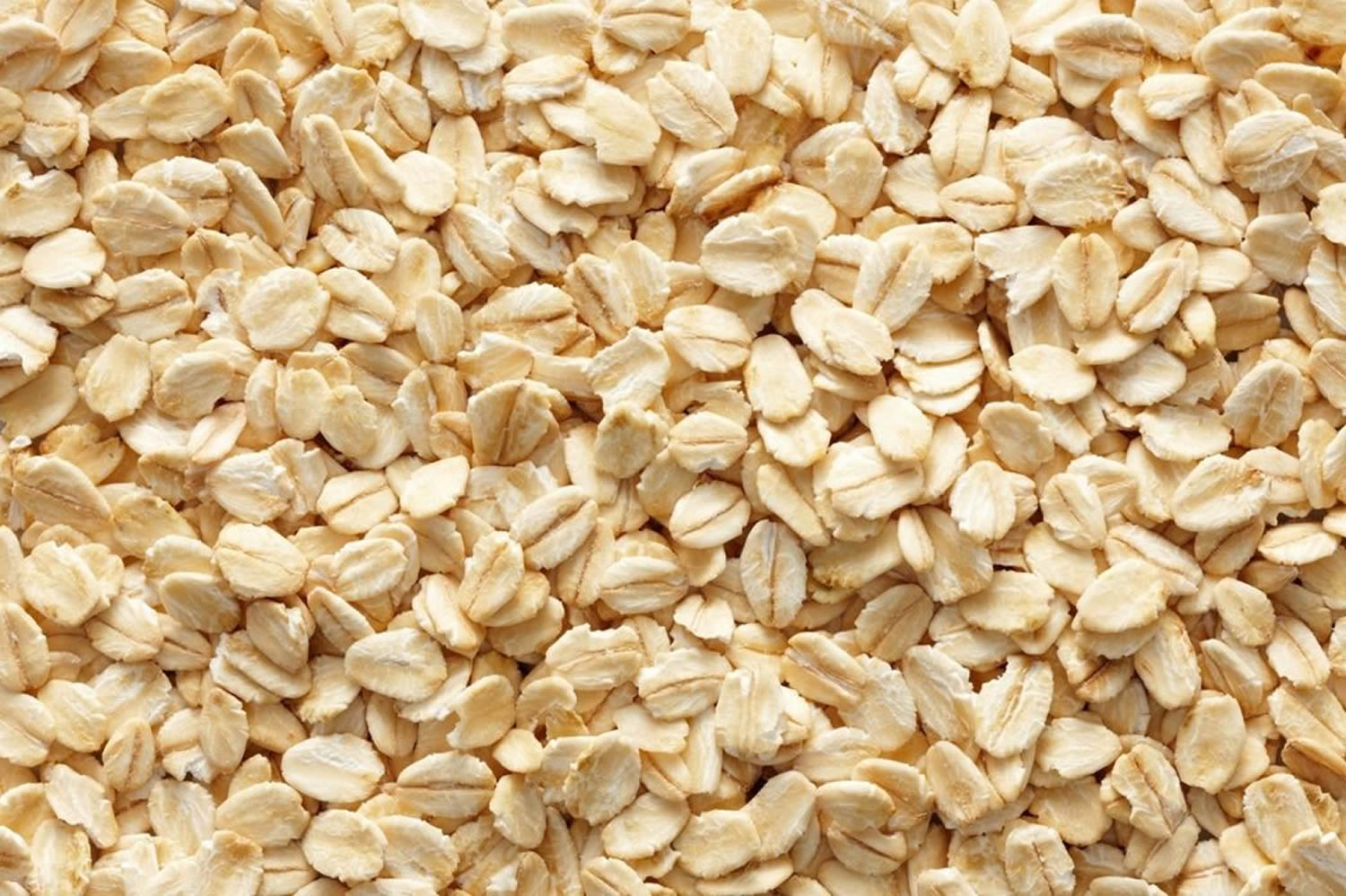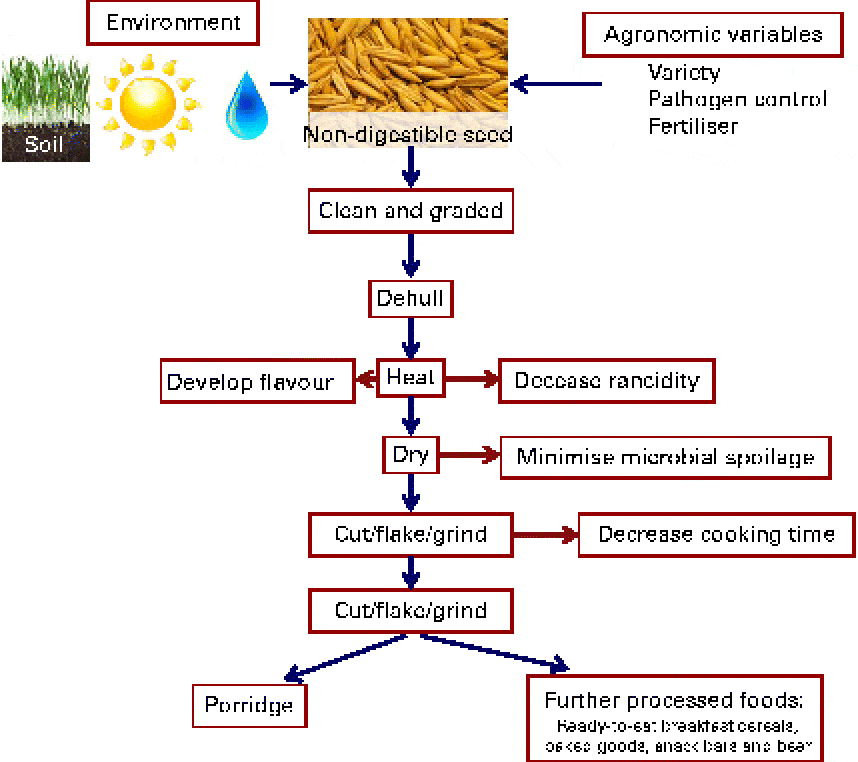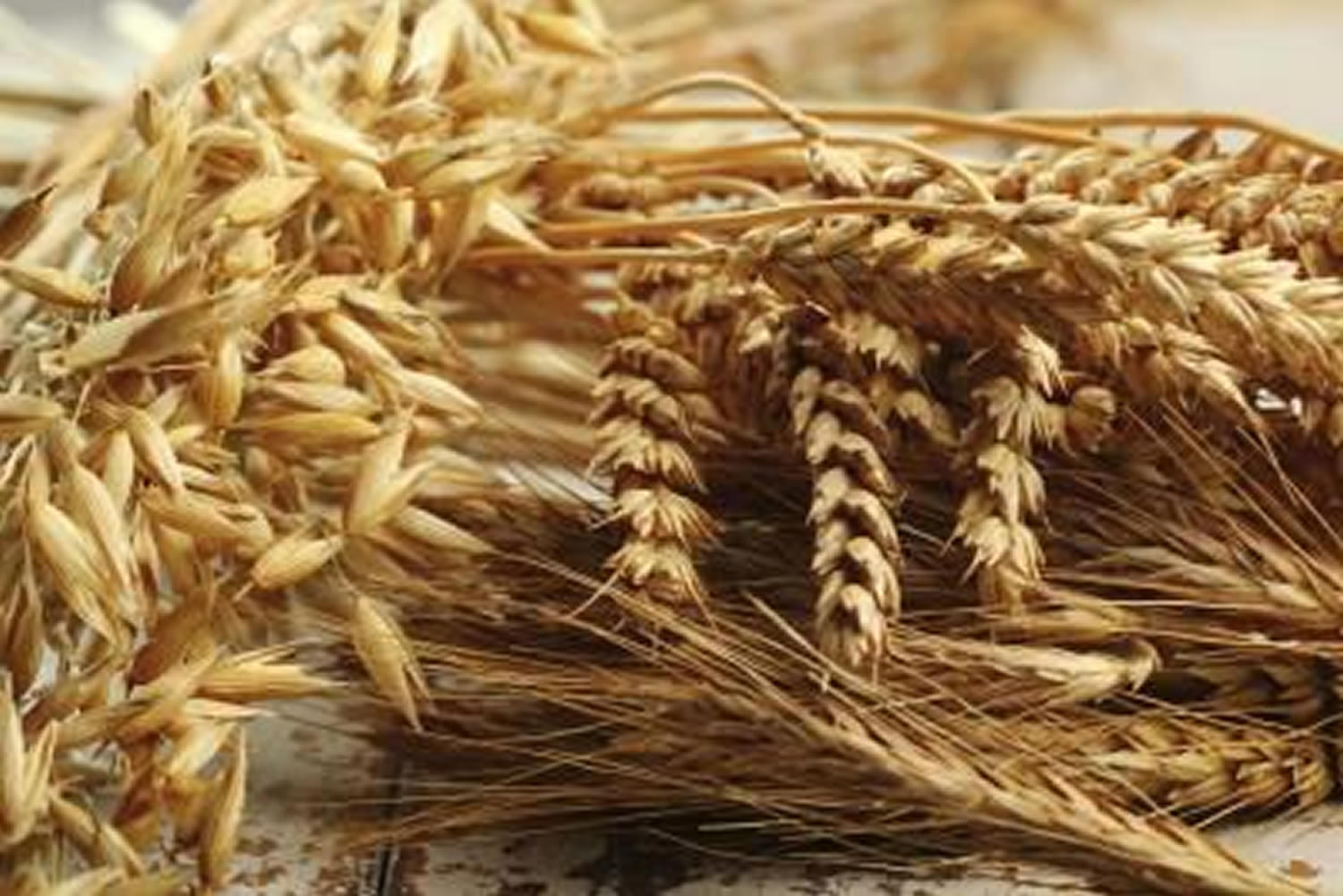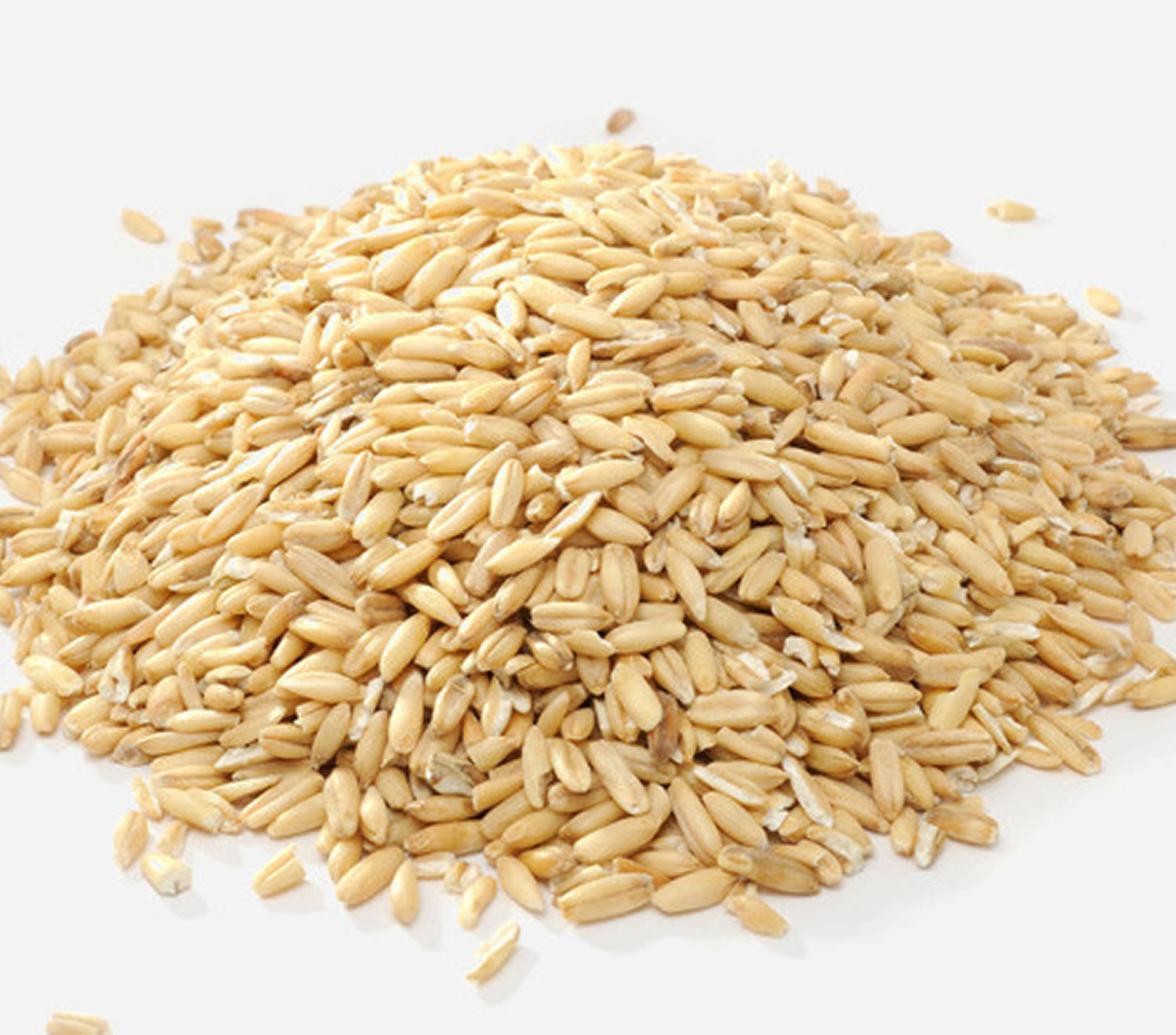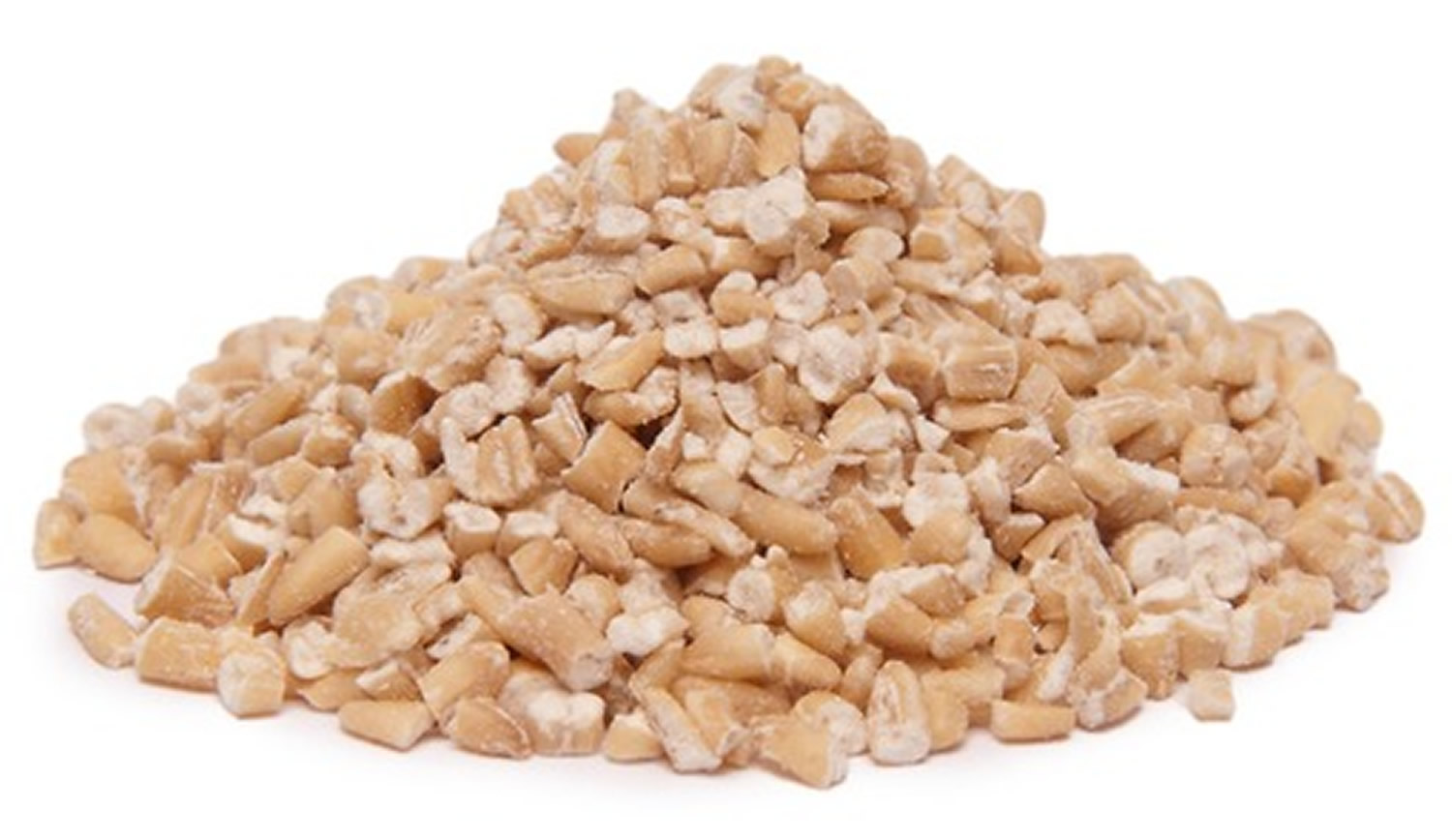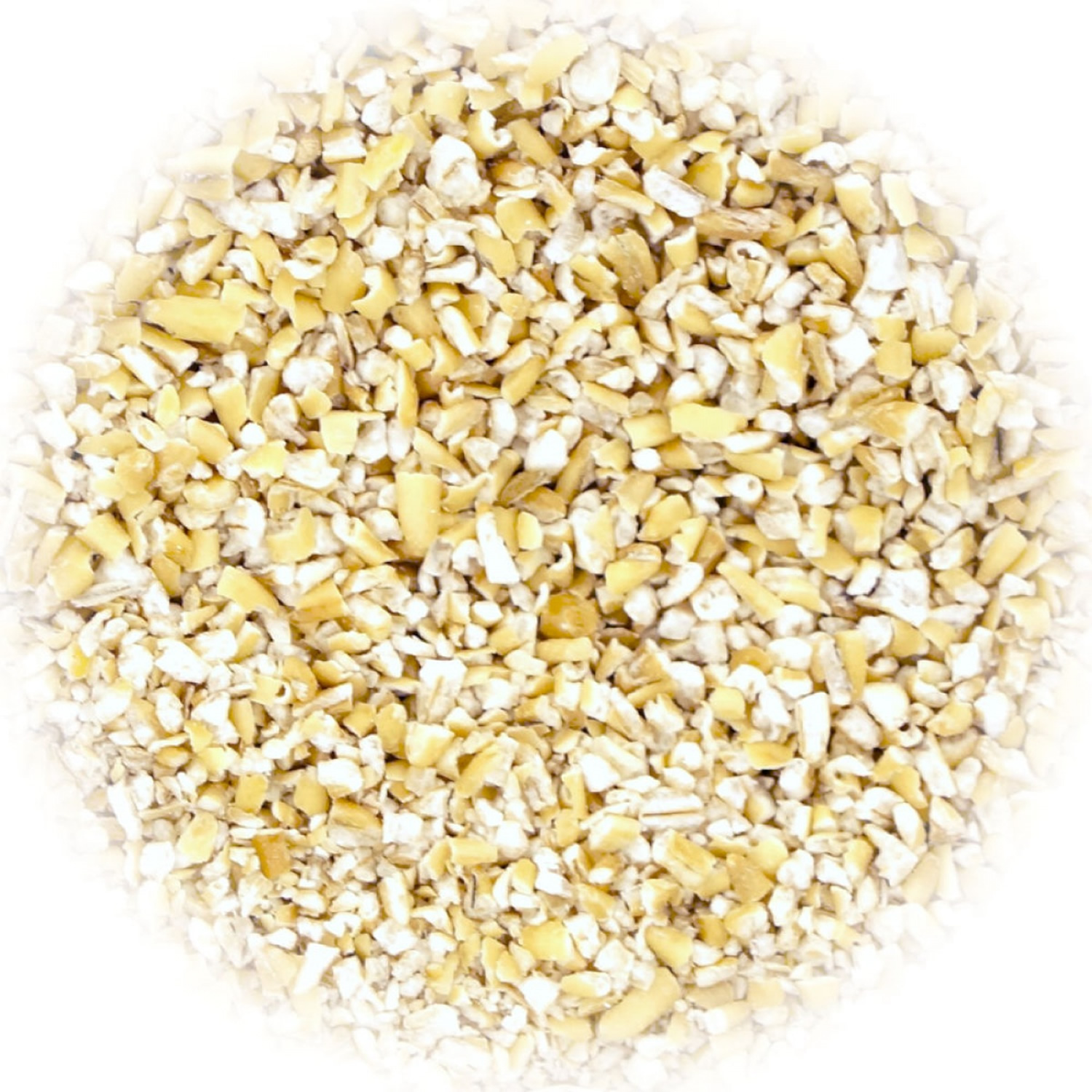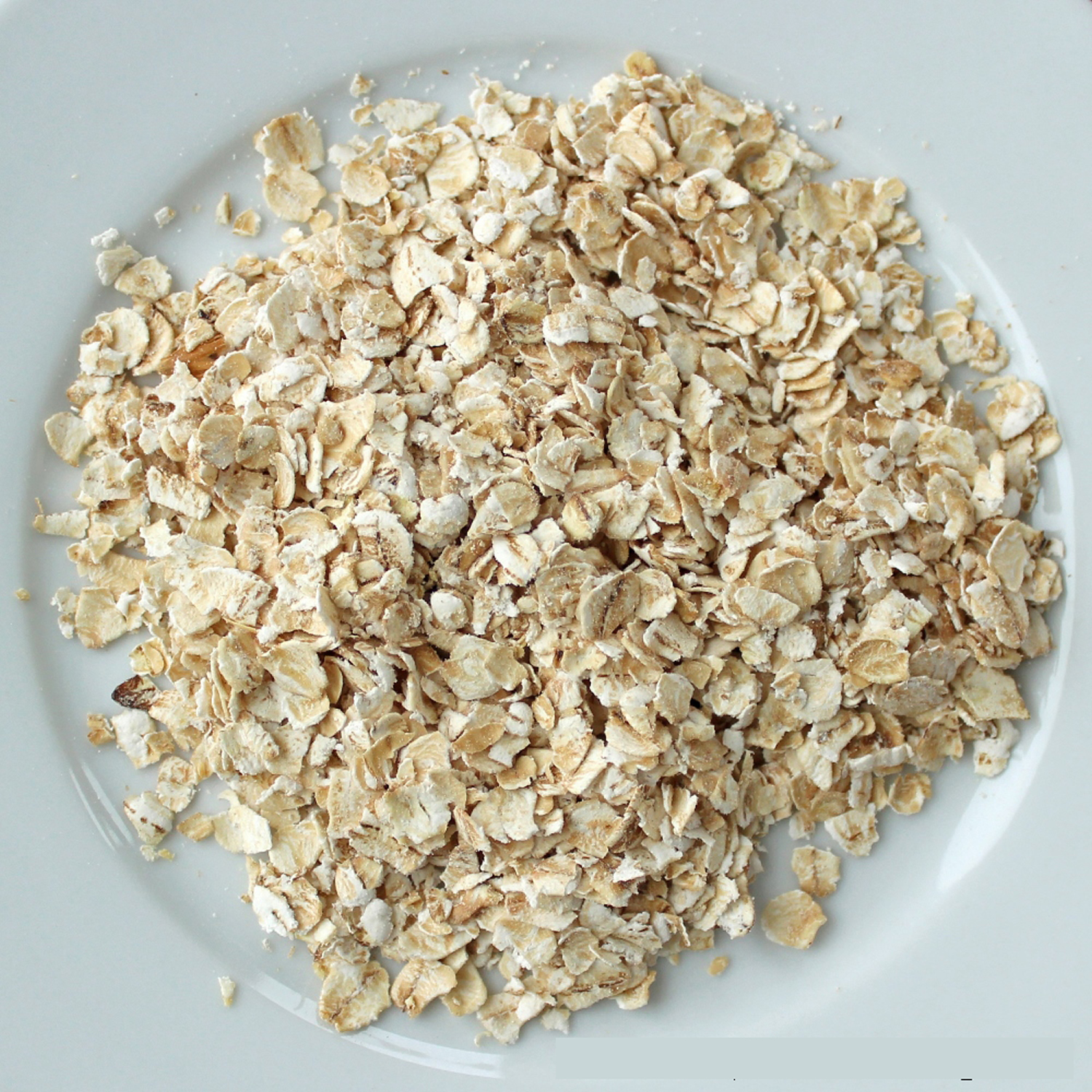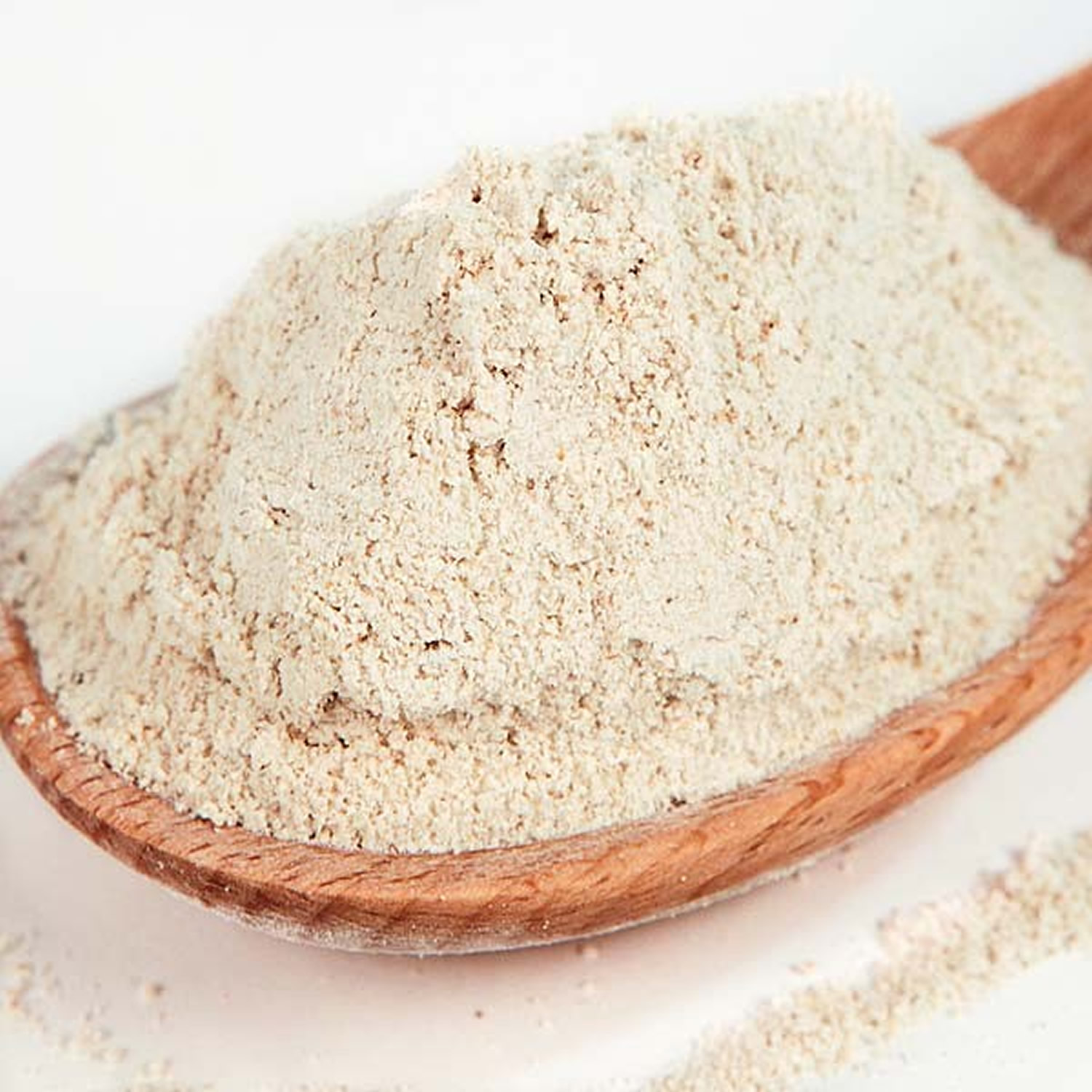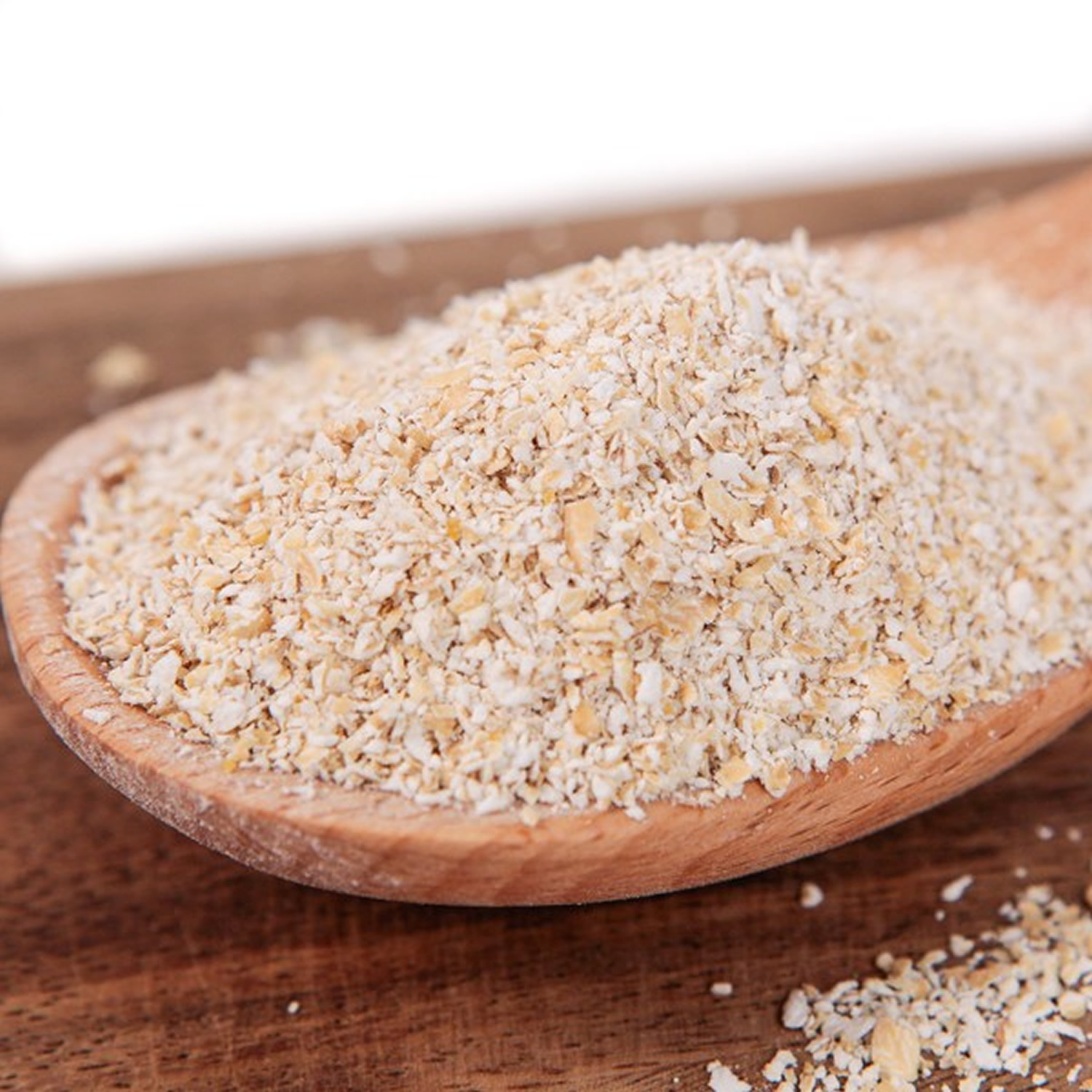What is Oatmeal ?
Oats (Avena sativa) are classified as a whole grain and are high in soluble fibre, β-glucan, lipids, protein and specific micronutrients, as well as act as a unique source of polyphenols (avenanthramides) 1. Oats are somewhat unusual in that they contain 6–8 % fat compared to 2–3 % fat in most other grains. Oats also contain high PUFA (35 % linoleic acid 2) and high levels of lipid-digesting enzymes. Whole grains are important dietary components of a healthy lifestyle, and the consumption of whole grains is advocated in the dietary guidelines and nutritional policies of many countries, including the USA (2015) 3, Australia (2013), Canada (2011), Mexico (2006), and various countries in South America, throughout Europe and Asia 4. The 2015-2020 Dietary Guidelines for Americans advised the public to consume at least half of all grains as whole grains, which typically means at least three servings of whole grains daily 3.
Oats also have a sweet flavor that makes them a favorite for breakfast cereals. There are many unique “overnight oatmeal” recipes out there, but all you need to remember is the most basic recipe. Try this: simply mix 1/4 cup oats and 1/2 cup low-fat milk (or milk substitute like soy milk) in a container or jar that can be sealed tightly, and leave it in the fridge overnight 5. That’s it! When you wake up your oatmeal is ready for breakfast. You can “dress” up your oatmeal by mixing in a tablespoon of peanut butter for some added protein, or add a bit of vanilla extract and cinnamon for additional flavor.
Unique among grains, oats almost never have their bran and germ removed in processing. So if you see oats or oat flour on the label, relax: you’re virtually guaranteed to be getting whole grain 6. However, an oat kernel is largely non-digestible and thus must be utilised in milled form to reap its nutritional benefits. This is primarily because the outer portion of the seed (the hull) is designed to protect the seed from harsh environments. The hull is so effective that, if the seed is consumed unprocessed, it can pass through the entire digestive system with little or no digestion – a reproduction strategy of the plant to increase seed dispersal. Milling and other processing steps are therefore essential in converting the seed to food. Milling is made up of numerous steps, the most important being dehulling to expose the digestible groat, heat processing to inactivate enzymes that cause rancidity, and cutting, rolling or grinding to convert the groat into a product that can be used directly in oatmeal or can be used as a food ingredient in products such as bread, ready-to-eat breakfast cereals and snack bars. Oats can also be processed into oat bran and fibre to obtain high-fibre-containing fractions that can be used in a variety of food products 7.
How to be sure you’re getting whole oats: When you see oats or oatmeal or oat groats on an ingredient list, they are almost invariably whole oats.
In the U.S., most oats are steamed and flattened to produce rolled oats, sold as “old-fashioned” or regular oats, quick oats, and instant oats. The more oats are flattened and steamed, the quicker they cook and the softer they become. If you prefer a chewier, nuttier texture, consider steel-cut oats, also sometimes called Irish or Scottish oats. Steel-cut oats consist of the entire oat kernel (similar in look to a grain of rice), sliced once or twice into smaller pieces to help water penetrate and cook the grain. Cooked for about 20-30 minutes, steel-cut oats create a breakfast porridge that delights many people who didn’t realize they love oatmeal 6.
Scientific studies have concluded that like barley, oats contain a special kind of fiber called beta-glucan found to be especially effective in lowering cholesterol. Recent research reports indicate that oats also have a unique antioxidant, avenanthramides, that helps protect blood vessels from the damaging effects of LDL cholesterol.
Types of Oatmeal
How are these varieties of oats different from one another ?
Mostly, it’s how they are processed. Oats have several unique properties that make their milling different from other cereal grains 8 – their hull is not connected to the endosperm, they have a higher fat content than most cereal grains and they contain high levels of soluble dietary fibres. Oats have a hull that consists mainly of cellulose, hemicelluloses and lignin. Within the hull is the groat, which comprises 68–72 % of the kernel 9. The oat is most commonly processed as a whole grain because its groat is softer than other grains such as wheat, and thus cannot be easily converted into separate germ, endosperm and bran fractions. The outer layer of the groat is an important source of protein, neutral lipids, β-glucan, phenolics and niacin, and is sometimes separated from the groat to produce oat bran. The inner endosperm consists of proteins, starch and β-glucan while the germ contains mainly lipids and proteins. These oat components and its unique physiological structure require that oats are processed differently from other grains, and also provide them with some unique nutritional qualities that make them an important, albeit underutilised and valued, food product and sometimes an ingredient in other food products. This article reviews the steps required for oat milling, the opportunities for extracting/concentrating unique components from oats for use as food ingredients and the further use of oat products in consumer food products. Many of the steps described later can vary from mill to mill, so the discussion is intended to give a broad overview of how oat grains are converted to human food (see also Fig. 1).
The instant oatmeal initially appears to contain fewer calories, but there is less of it. There is less in the packet than if you had made oatmeal from scratch with one of the other varieties.
Oatmeal calories
Most kinds of oats have anywhere from 140 to 170 calories, 23 to 29 gm carbohydrate, 4-7 gm of protein, and 3-5 gm of fiber. If you like the instant variety of oats, be sure to choose plain varieties as the flavored ones usually contain added sugar, sodium, and other additives.
All oats, with the exception of flavored and sweetened instant oats, have a relatively low glycemic index. Glycemic index refers to how quickly and how much of a spike in blood sugar a particular food causes. Eating foods with a low glycemic index is thought to help keep blood sugar stabilized as well as keep you feeling full for a longer period of time. Because they are processed less, steel-cut oats will likely keep you feeling full longer than their quick or instant counterparts. But the difference in glycemic index is negligible.
As you can see from the breakdown below, they are very similar nutritionally. Choosing which variety of oats to use comes down to personal preferences and how you plan to use them.
Fig. 1. A flow diagram showing the production of oats on the farm through typical oat-processing operations and production of human foods. The impact of processing operations on the farm variables is included in other sections in this special addition. How the quality of the oats is affected by some processing steps are included in the side boxes.
Raw Oats newly harvested
This is what oats look like before the kernels (groats) are separated from the hulls and stalks. Admittedly, you won’t see them this way in stores, but we thought you’d like to see what they look like fresh from the fields.
Whole Oat Groats
A groat is another name for a grain kernel. Whole oat groats are the result of simply harvesting oats, cleaning them, and removing their inedible hulls. You can most often find these in health food stores. They take the longest to cook.
Steel Cut Oats
If you cut groats into two or three pieces with a sharp metal blade, you get steel cut oats. They cook quicker than oat groats, because water can more easily penetrate the smaller pieces. Steel cut oats are also sometimes called Irish oatmeal. While not usually used for baked goods, they work well for cooked cereals, and are well suited for overnight cooking in the slow cooker.
Table 1. Steel Cut Oats Nutrition Content
Nutrient | Unit | cup 44 g | Value per 100 g | ||||||||||||||||
|---|---|---|---|---|---|---|---|---|---|---|---|---|---|---|---|---|---|---|---|
| Approximates | |||||||||||||||||||
| Energy | kcal | 170 | 386 | ||||||||||||||||
| Protein | g | 7.00 | 15.91 | ||||||||||||||||
| Total lipid (fat) | g | 3.00 | 6.82 | ||||||||||||||||
| Carbohydrate, by difference | g | 29.00 | 65.91 | ||||||||||||||||
| Fiber, total dietary | g | 5.0 | 11.4 | ||||||||||||||||
| Sugars, total | g | 0.00 | 0.00 | ||||||||||||||||
| Minerals | |||||||||||||||||||
| Calcium, Ca | mg | 20 | 45 | ||||||||||||||||
| Iron, Fe | mg | 1.80 | 4.09 | ||||||||||||||||
| Sodium, Na | mg | 0 | 0 | ||||||||||||||||
| Vitamins | |||||||||||||||||||
| Vitamin C, total ascorbic acid | mg | 0.0 | 0.0 | ||||||||||||||||
| Vitamin A, IU | IU | 0 | 0 | ||||||||||||||||
| Lipids | |||||||||||||||||||
| Fatty acids, total saturated | g | 0.502 | 1.140 | ||||||||||||||||
| Fatty acids, total trans | g | 0.000 | 0.000 | ||||||||||||||||
| Cholesterol | mg | 0 | 0 | ||||||||||||||||
Scottish Oatmeal
Instead of cutting oats with a steel blade, the Scots traditionally stone-grind them, creating broken bits of varying sizes, which some say results in a creamier porridge than steel-cutting. They cook quicker than steel-cut oats, and you will get a creamier texture while keeping the nutty flavor.
Table 2. Scottish Oatsmeal Nutrition Content
Nutrient | Unit | cup 36 g | Value per 100 g | ||||||||||||||||
|---|---|---|---|---|---|---|---|---|---|---|---|---|---|---|---|---|---|---|---|
| Approximates | |||||||||||||||||||
| Energy | kcal | 140 | 389 | ||||||||||||||||
| Protein | g | 6.00 | 16.67 | ||||||||||||||||
| Total lipid (fat) | g | 2.50 | 6.94 | ||||||||||||||||
| Carbohydrate, by difference | g | 23.00 | 63.89 | ||||||||||||||||
| Fiber, total dietary | g | 4.0 | 11.1 | ||||||||||||||||
| Sugars, total | g | 0.00 | 0.00 | ||||||||||||||||
| Minerals | |||||||||||||||||||
| Calcium, Ca | mg | 20 | 56 | ||||||||||||||||
| Iron, Fe | mg | 1.80 | 5.00 | ||||||||||||||||
| Sodium, Na | mg | 0 | 0 | ||||||||||||||||
| Vitamins | |||||||||||||||||||
| Vitamin C, total ascorbic acid | mg | 0.0 | 0.0 | ||||||||||||||||
| Vitamin A, IU | IU | 0 | 0 | ||||||||||||||||
| Lipids | |||||||||||||||||||
| Fatty acids, total saturated | g | 0.500 | 1.390 | ||||||||||||||||
| Fatty acids, total trans | g | 0.000 | 0.000 | ||||||||||||||||
| Cholesterol | mg | 0 | 0 | ||||||||||||||||
Rolled Oats – Regular (Old fashioned)
Rolled oats (sometimes called old fashioned oats) are created when oat groats are steamed and then rolled into flakes. This process stabilizes the healthy oils in the oats, so they stay fresh longer, and helps the oats cook faster, by creating a greater surface area. This creates the flat, oval look that most people associate with uncooked oatmeal. These oats cook faster than steel-cut oats, and have a thick, creamy texture. They work well for cooked cereals or a variety of baked goods, like muffins, granola bars, cookies, or breads.
Table 3. Rolled Oats (Raw) Nutrition Content
Nutrient | Unit | cup 26 g | Value per 100 g | ||||||||||||||||
|---|---|---|---|---|---|---|---|---|---|---|---|---|---|---|---|---|---|---|---|
| Approximates | |||||||||||||||||||
| Energy | kcal | 100 | 385 | ||||||||||||||||
| Protein | g | 4.00 | 15.38 | ||||||||||||||||
| Total lipid (fat) | g | 2.00 | 7.69 | ||||||||||||||||
| Carbohydrate, by difference | g | 17.00 | 65.38 | ||||||||||||||||
| Fiber, total dietary | g | 3.0 | 11.5 | ||||||||||||||||
| Minerals | |||||||||||||||||||
| Calcium, Ca | mg | 20 | 77 | ||||||||||||||||
| Iron, Fe | mg | 1.08 | 4.15 | ||||||||||||||||
| Lipids | |||||||||||||||||||
| Fatty acids, total saturated | g | 0.499 | 1.920 | ||||||||||||||||
Rolled Oats – Quick or Instant
If you roll the oat flakes thinner and/or steam them longer, you create quick oats and ultimately instant oats. The nutrition stays the same (these are all whole grains) but the texture changes. They cook more quickly than old-fashioned oats but tend to lose more of their texture. They also work well for cooked cereals and baked goods.
Table 4. Rolled Oats (Quick or Instant) Nutrition Content
Nutrient | Unit | cup 40 g | Value per 100 g | ||||||||||||||||
|---|---|---|---|---|---|---|---|---|---|---|---|---|---|---|---|---|---|---|---|
| Approximates | |||||||||||||||||||
| Energy | kcal | 150 | 375 | ||||||||||||||||
| Protein | g | 5.00 | 12.50 | ||||||||||||||||
| Total lipid (fat) | g | 2.50 | 6.25 | ||||||||||||||||
| Carbohydrate, by difference | g | 27.00 | 67.50 | ||||||||||||||||
| Fiber, total dietary | g | 4.0 | 10.0 | ||||||||||||||||
| Sugars, total | g | 1.00 | 2.50 | ||||||||||||||||
| Minerals | |||||||||||||||||||
| Calcium, Ca | mg | 0 | 0 | ||||||||||||||||
| Iron, Fe | mg | 1.80 | 4.50 | ||||||||||||||||
| Sodium, Na | mg | 0 | 0 | ||||||||||||||||
| Vitamins | |||||||||||||||||||
| Vitamin C, total ascorbic acid | mg | 0.0 | 0.0 | ||||||||||||||||
| Vitamin A, IU | IU | 0 | 0 | ||||||||||||||||
| Lipids | |||||||||||||||||||
| Fatty acids, total saturated | g | 0.500 | 1.250 | ||||||||||||||||
| Fatty acids, total monounsaturated | g | 1.000 | 2.500 | ||||||||||||||||
| Fatty acids, total polyunsaturated | g | 1.000 | 2.500 | ||||||||||||||||
| Fatty acids, total trans | g | 0.000 | 0.000 | ||||||||||||||||
| Cholesterol | mg | 0 | 0 | ||||||||||||||||
Oat Flour
Groats or oat flakes can be ground with a pin or hammer mill into flour. Oat flour is primarily used for baby food and ready-to-eat cereals 8.
Table 5. Oat Flour Nutrition Content
Nutrient | Unit | cup 40 g | Value per 100 g | ||||||||||||||||
|---|---|---|---|---|---|---|---|---|---|---|---|---|---|---|---|---|---|---|---|
| Approximates | |||||||||||||||||||
| Energy | kcal | 160 | 400 | ||||||||||||||||
| Protein | g | 7.00 | 17.50 | ||||||||||||||||
| Total lipid (fat) | g | 3.00 | 7.50 | ||||||||||||||||
| Carbohydrate, by difference | g | 26.00 | 65.00 | ||||||||||||||||
| Fiber, total dietary | g | 4.0 | 10.0 | ||||||||||||||||
| Sugars, total | g | 0.00 | 0.00 | ||||||||||||||||
| Minerals | |||||||||||||||||||
| Calcium, Ca | mg | 20 | 50 | ||||||||||||||||
| Iron, Fe | mg | 1.80 | 4.50 | ||||||||||||||||
| Sodium, Na | mg | 0 | 0 | ||||||||||||||||
| Vitamins | |||||||||||||||||||
| Vitamin C, total ascorbic acid | mg | 0.0 | 0.0 | ||||||||||||||||
| Vitamin A, IU | IU | 0 | 0 | ||||||||||||||||
| Lipids | |||||||||||||||||||
| Fatty acids, total saturated | g | 0.500 | 1.250 | ||||||||||||||||
| Fatty acids, total trans | g | 0.000 | 0.000 | ||||||||||||||||
| Cholesterol | mg | 0 | 0 | ||||||||||||||||
Oat Bran
Oat flour can be separated into coarse and fine fractions. The coarse fraction is referred to as bran that comes from the outer aleurone and subaleurone layers of the groat and is higher in fibre, protein, vitamins and minerals, and is slightly higher in fat 7. The fine fraction has a high starch content. The coarser bran fraction is separated by shifting the oat flour. According to the American Association of Cereal Chemists 11 and the US Food and Drug Administration, oat bran must have a total dietary fibre content of at least 16 %, with one-third of the fibre being soluble and a β-glucan content of at least 5·5 %.
Table 6. Oat Bran Nutrition Content
Nutrient | Unit | Value per 100 g | cup 94 g | ||||||||||||||||
|---|---|---|---|---|---|---|---|---|---|---|---|---|---|---|---|---|---|---|---|
| Approximates | |||||||||||||||||||
| Water | g | 6.55 | 6.16 | ||||||||||||||||
| Energy | kcal | 246 | 231 | ||||||||||||||||
| Protein | g | 17.30 | 16.26 | ||||||||||||||||
| Total lipid (fat) | g | 7.03 | 6.61 | ||||||||||||||||
| Carbohydrate, by difference | g | 66.22 | 62.25 | ||||||||||||||||
| Fiber, total dietary | g | 15.4 | 14.5 | ||||||||||||||||
| Sugars, total | g | 1.45 | 1.36 | ||||||||||||||||
| Minerals | |||||||||||||||||||
| Calcium, Ca | mg | 58 | 55 | ||||||||||||||||
| Iron, Fe | mg | 5.41 | 5.09 | ||||||||||||||||
| Magnesium, Mg | mg | 235 | 221 | ||||||||||||||||
| Phosphorus, P | mg | 734 | 690 | ||||||||||||||||
| Potassium, K | mg | 566 | 532 | ||||||||||||||||
| Sodium, Na | mg | 4 | 4 | ||||||||||||||||
| Zinc, Zn | mg | 3.11 | 2.92 | ||||||||||||||||
| Vitamins | |||||||||||||||||||
| Vitamin C, total ascorbic acid | mg | 0.0 | 0.0 | ||||||||||||||||
| Thiamin | mg | 1.170 | 1.100 | ||||||||||||||||
| Riboflavin | mg | 0.220 | 0.207 | ||||||||||||||||
| Niacin | mg | 0.934 | 0.878 | ||||||||||||||||
| Vitamin B-6 | mg | 0.165 | 0.155 | ||||||||||||||||
| Folate, DFE | µg | 52 | 49 | ||||||||||||||||
| Vitamin B-12 | µg | 0.00 | 0.00 | ||||||||||||||||
| Vitamin A, RAE | µg | 0 | 0 | ||||||||||||||||
| Vitamin A, IU | IU | 0 | 0 | ||||||||||||||||
| Vitamin E (alpha-tocopherol) | mg | 1.01 | 0.95 | ||||||||||||||||
| Vitamin D (D2 + D3) | µg | 0.0 | 0.0 | ||||||||||||||||
| Vitamin D | IU | 0 | 0 | ||||||||||||||||
| Vitamin K (phylloquinone) | µg | 3.2 | 3.0 | ||||||||||||||||
| Lipids | |||||||||||||||||||
| Fatty acids, total saturated | g | 1.328 | 1.248 | ||||||||||||||||
| Fatty acids, total monounsaturated | g | 2.376 | 2.233 | ||||||||||||||||
| Fatty acids, total polyunsaturated | g | 2.766 | 2.600 | ||||||||||||||||
| Cholesterol | mg | 0 | 0 | ||||||||||||||||
| Other | |||||||||||||||||||
| Caffeine | mg | 0 | 0 | ||||||||||||||||
Benefits of Oatmeal
Scientific studies have concluded that like barley, oats contain a special kind of fiber called beta-glucan found to be especially effective in lowering cholesterol. The water-soluble, mixed-linkage β-glucan, a form of soluble dietary fibre, is considered the main biologically active component responsible for the capacity of many oat products to lower postprandial glycaemia and fasting plasma cholesterol in human subjects 12. Many in vitro animal and human studies have shown that water-soluble β-glucan is one of the main bioactive components responsible for a number of the putative health benefits attributed to oat products 13. In breakfast cereals containing 3 g of β-glucan/serving, high-MW (2,210,000 g/mol) or a medium-MW (530,000 g/mol) lowered LDL cholesterol by ≈0.2 mmol/L (5%). However, when the molecular weight of β-glucan was < 210 000 g/mol, the ability of the breakfast cereal to reduce LDL-cholesterol was decreased by 50 % 14.
Most β-glucan in the oat groat is located in the inner layer of the cell wall that is enclosed by an insoluble cellulosic and hemicellulosic outer layer 13. It is generally less water soluble than extracted β-glucan material. Because the cell walls in the inner endosperm are thinner than in the aleurone and subaleurone layers, it appears that β-glucan in the milled whole groat is more easily extracted than that in oat bran 15, 16. For example, Beer et al. 15 has found that the proportion of soluble β-glucan extracted from oat brans and rolled oats, by hot-water extraction in conjunction with a heat-stable α-amylase treatment, was 30–65 and 70 %, respectively. Under physiological conditions, the percentage of extractable β-glucan was also noticeably higher in rolled oats than in bran samples. Based on the results of physiological and human studies to date, there is strong evidence to show that oat β-glucan lowers total and LDL-cholesterol and reduces after meal effect glycaemia and insulinaemia when it is ingested in sufficiently high doses and at a suitably high molecular weight 12.
- Oats and cardiovascular disease risk markers
High consumption of whole-grain food such as oats is associated with a reduced risk of cardiovascular disease and type 2 diabetes. The present systematic literature review 17 concluded that regular consumption of oats or oat bran has a beneficial effect on total cholesterol and LDL-cholesterol, particularly in hypercholesterolaemic (high blood cholesterol) subjects. The intervention trials described in the present review can generally be divided into three groups depending on the product used in the intervention: oat bran; whole-grain oat cereals; oatmeal. For the studies that showed a significant reduction in total cholesterol and/or LDL-cholesterol, the range of doses used was 25–135 g/d for oat bran, 45–90 g/d for whole-grain oat cereals and 60–150 g/d for oatmeal. So it appears that the form of oats does not really affect the outcome. The doses required to reach a significant effect were also similar. However, studies using amounts below 50 g/d are scarce, and more well-designed dose–response studies are needed to confirm the minimum amount required to have a clinical beneficial effect. The 3–6 % cholesterol reduction described in the larger studies would translate to a 6–18 % decrease in coronary heart disease risk. Some studies reported significant effects on blood cholesterol only 2 weeks after beginning the intervention, so it is likely that the benefits of increasing oats intake start very shortly after changing the diet. How long these effects on blood cholesterol remain if subjects revert to their original diet remains to be determined. However, there is no indication that it would significantly modulate insulin sensitivity. It is still unclear whether increased oat consumption would significantly affect other risk markers for cardiovascular disease risk. More comprehensive, properly controlled intervention trials with adequate sample sizes are required to answer this question 17.
To investigate the effect of bread formulated with 6 g of beta-glucan (oat soluble fiber) on serum lipids in overweight normotensive subjects with mild to moderate hypercholesterolemia 18. Thirty-eight male subjects [mean age 59.8 yr, mean body mass index (BMI) 28.3 kg/m(2)] who were eligible for the study ate an normal diet for a 1-week period. They were then divided into 2 groups: group A (19 subjects), who were maintained on American Heart Association (AHA) Step II diet, including whole wheat bread, and group B (19 subjects), who were maintained on AHA Step II diet containing high levels of monounsaturated fatty acids plus bread containing 6 g of beta-glucan (Nutrim-OB) for 8 weeks. Plasma lipids and glucose were measured at baseline and after weeks 8 in all subjects. All subjects were advised to walk for 60 minutes every day. Six grams of beta-glucan from oats added to the AHA Step II diet and moderate physical activity improved lipid profile and caused a decrease in weight and, thus, reduced the risk of cardiovascular events in overweight male individuals with mild to moderate hypercholesterolemia. The diet with added beta-glucan was well accepted and tolerated 18.
This randomized, double-blind, controlled trial 19 evaluated the influence of low fat, low saturated fat food products that contained free tall oil-based phytosterols (TOP) and oat beta-glucan (from whole oats and bran concentrate) on serum lipid concentrations in adults with mild-to-moderate hypercholesterolemia. The results of this trial suggest that consumption of a group of low fat, TOP and beta-glucan- containing foods is a useful adjunct in the dietary management of hypercholesterolemia 19.
In another randomized controlled trial of comparing oatmeal consumption versus noodle consumption on blood lipids of urban Chinese adults with hypercholesterolemia 20. The oat group (n=85) consumed 100 grams of instant oat cereal versus the control group (n=81) who consumed 100 grams of wheat flour-based noodles daily for 6 weeks. Laboratory and anthropometric measurements were conducted at baseline and at the end of the 6-week intervention. Dietary fiber intake increased significantly in the oat group compared to the control group at the end of the 6-week intervention. Total-, LDL-cholesterol and waist circumference decreased significantly in the oat group compared to the control. HDL-cholesterol decreased significantly in the control group versus the oat group. There were no significant changes in blood pressure, other anthropometric or laboratory measures between the two groups at the end of the intervention 20.
In a 6-week randomised controlled trial was conducted to test whether 1·5 g/d β-glucan provided as ready-to-eat oat flakes was as effective in lowering cholesterol as 3·0 g/d from oats porridge 21. Eighty-seven mildly hypercholesterolaemic ( ≥ 5 mmol/l and < 7·5 mmol/l) men and women assigned to one of three diet arms (25 % energy (E%) protein; 45 E% carbohydrate; 30 E% fat, at energy requirements for weight maintenance): (1) minimal β-glucan (control); (2) low-dose oat β-glucan (1·5 g β-glucan; oats low – OL) or (3) higher dose oat β-glucan (3·0 g β-glucan; oats high – OH). Changes in total cholesterol and LDL-cholesterol (LDL-C) from baseline were assessed. Total cholesterol reduced significantly in all groups ( – 7·8 % in the 3·0 g β-glucan oat group, – 7·2 % in the 1·5 g β-glucan oat group and – 5·5 % in control groups), as did LDL-C (- 8·4 % in the 3·0 g β-glucan oat group, – 8·5 % in the 1·5 g β-glucan oat group and – 5·5 % in the control group). In responders only, β-glucan groups had higher reductions in LDL-Cholesterol compared with controls. Intakes of oat β-glucan were as effective at doses of 1·5 g/d compared with 3 g/d when provided in different food formats that delivered similar amounts of soluble β-glucan 21.
The United States Food and Drug Administration (FDA) approved a health claim for β-glucan soluble fiber from oats for reducing plasma cholesterol levels and risk of heart disease in 1997. Similarly, in 2004 the United Kingdom Joint Health Claims Initiative (JHCI) allowed a cholesterol-lowering health claim for oat β-glucan 22. In 2007, Health Canada, after careful evaluation, concludes on the basis of new research information that a dose of 3 g/day oat β-glucan consumed as part of a diet “free of saturated fatty acids” or “low in saturated fatty acids” could help to promote cardiovascular health 23.
Results of this analysis 22 show that studies conducted during the past 13 years support the suggestion that intake of oat β-glucan at daily doses of at least 3 g may reduce plasma total and low-density lipoprotein (LDL) cholesterol levels by 5-10% in normocholesterolemic or hypercholesterolemic subjects. Studies described herein have shown that, on average, oat consumption is associated with 5% and 7% reductions in total and LDL cholesterol levels, respectively. Significant scientific agreement continues to support a relationship between oat β-glucan and blood cholesterol levels, with newer data being consistent with earlier conclusions made by the FDA and JHCI 22.
- Oats and soy in lipid-lowering diets for women with hypercholesterolemia
To study possible synergistic effects of oats and soy on reducing total and low-density lipoprotein cholesterol (LDL-C) concentrations in human beings 24. Van Horn et.al., conducted a 9 week trial of four different diets: an oats/milk group, a wheat/soy group, an oats/soy group, and a wheat/milk group; on 127 postmenopausal women with moderate hypercholesterolemia. After 6 weeks on the intervention diet, total cholesterol and LDL-Cholesterol were further reduced for both the oats/soy group and oats/milk group. There were no significant further changes in total cholesterol, LDL-C, or high-density lipoprotein cholesterol levels in the wheat/soy and wheat/milk groups. Body mass index remained stable in all groups from Week 3 to Week 9 24.
In another study 25 comparing the effects of beta-glucans from oats or barley on serum lipoproteins (cholesterol) and postprandial glucose and insulin concentrations. Found that a daily consumption of 5 g of beta-glucans in a beverage from oats significantly lowered total-cholesterol by 7.4% and improved the lipid and glucose metabolism, while barley beta-glucans did not 25.
- Oats consumption and risk of cancer and overall mortality
A review of epidemiological studies on the intake of oats and oat-based products and its effect on the risk of chronic disease and deaths was performed 26. Seven studies were identified of cancer risk (two each on prostate and colorectal cancer, and one each on pancreatic, breast and endometrial cancer), and one study on overall mortality.
Oatmeal was one of the components of the healthy Nordic food index, whose association with total mortality was investigated in the Danish Diet, Cancer and Health cohort study (57,053 subjects aged 50–64 at baseline) 27. During 12 years of follow-up, 4126 of the cohort participants died. A one-point increase in the index score was associated with a significantly lower mortality for both men and women. Among the individual index components, whole-grain rye bread intake was the factor most consistently associated with lower mortality. An association was suggested for oatmeal intake for >20 g/d vs. ≤20 g/d was 0·91 in men and 0·97 in women.
In an analysis of 1025 cases of colorectal cancer diagnosed among 57,053 participants in the Danish Diet, Cancer and Health cohort study over a 13-year period, no association was found with the healthy Nordic food index, which includes oatmeal intake 28. Consumption of oatmeal was similar among those diagnosed with colorectal cancer and those who remained free of the disease. The HELGA cohort comprises 108,000 Danish, Swedish and Norwegian people (including the Danish Diet, Cancer and Health cohort), of whom 1123 developed colorectal cancer during a median of 11 years of follow-up. This cohort was analysed for the intake of whole-grain products, including whole-grain oats 29. The intake of whole-grain products was associated with a lower incidence of colorectal cancer; however, no consistent association was observed with the intake of whole-grain oats 29.
In conclusion, few epidemiological studies have been conducted on oats and oat-based products and disease risk: overall, they provide weak evidence of a protective effect of oats intake on cancer risk and overall mortality. No conclusions can therefore be confidently drawn on the presence or absence of a protective effect of oats consumption on cancer risk in epidemiological studies. The available results, however, are limited and primarily based on a single cohort study from Denmark, and are limited by heterogeneity in study populations and dietary exposure assessment methods between studies 26.
- Early introduction of oats associated with decreased risk of persistent asthma and early introduction of fish with decreased risk of allergic rhinitis
There are two interesting observations in the present study 30. While there is widespread belief that introducing solid foods to children too early may cause later health problems, a Finnish prospective study of 1293 children found that those introduced earlier to oats were in fact less likely to develop persistent asthma 31. The first is the apparent association between early introduction of oats and protection against persistent asthma. Oats is a commonly used cereal in Finland, as porridge and bread. It is often grouped together with wheat, rye and barley, but it is not closely related to these; e.g. patients with coeliac disease cannot eat wheat, rye or barley, but can use oats 32. Animal and cell experiments suggest that oats may have immunomodulatory and anti-inflammatory properties 33, 34. The same is true for fish – the second interesting finding was that early introduction of fish associates with a reduced frequency of allergic rhinitis. Fish oils may modulate inflammatory responses and have inconsistently modified the risk of allergic diseases and asthma 35.
The present findings imply that delaying introduction of oats in infancy may increase the risk of asthma by the age of 5 years at least in children with genetic susceptibility for type 1 diabetes. These observations need to be confirmed in other populations 30.
- Beneficial effects of oats in the gluten-free diet
The present study was to investigate the nutritional and symptomatic effects of including oats in the gluten-free diet, as well as the patients’ subjective experiences. Twenty two adult coeliac patients included large amounts of oats in their diet. Food intake, gastrointestinal symptoms, blood samples and body weight were examined and compared with examination at baseline. Diet compliance was checked monthly. The results are based on fifteen patients eating oats for 2 years plus three with only 6-months consumption. Temporary increased flatulence was experienced the first few weeks, as well as improved bowel function with oats in the diet. All patients who carried out the whole study period wanted to continue eating oats after the study, as they found that addition of oats in the gluten-free diet gave more variation, better taste and satiety. Oats improved the nutritional value of the gluten-free diet, had no negative effects on nutritional status and were appreciated by the subjects. Including oats can help coeliac patients following a strict gluten-free diet 36.
Recent evidence suggests that oats that are pure and uncontaminated with other gluten-containing grains, if taken in limited quantities, are safe for most individuals with celiac disease. For adults, up to 70 g (1/2 to 3/4 cup) of oats per day and for children, up to 25 g (1/4 cup) per day are safe to consume 37.
Oat-based foods
The most common way to eat oats is oatmeal, and several different types of oatmeal can be purchased in most grocery stores, including regular, quick-cooking and Irish and Scottish oatmeal 38. To make oats more digestible and easier to eat (namely, softer), the starch in the groat must become gelatinised 39. Starch consists of granules made up of of two different glucose-containing polysaccharides: amlyose and amylopectin. Converting oats into a more desirable food requires heating the starch in the presence of water so the water can move into the granule, allowing it to swell and become soft. Quick-cooking oatmeal contains oat flakes that are thinner than regular (e.g. old fashioned) oatmeal, so their starch can absorb water more quickly and thus decrease the cooking time. Irish oatmeal contains steel-cut oats and thus has the longest cooking time. Scottish oatmeal is a coarsely ground meal that also takes a long time to cook and has a consistency of porridge. The creamy texture of oatmeal comes from the water-binding properties of its soluble fibres.
Ready-to-eat breakfast cereals are most commonly made from a batter containing oat flour, and are extruded (expanded) or rolled and baked. The starch granules in these products can easily absorb moisture and will therefore soften without cooking, such as when they are mixed with milk. Oats are also used to make products such as granola, snack bars, cookies and pancakes, and are used as an extender in meat products such as black and white puddings and haggis, and as a carbohydrate source for fermented foods such as beer. The lipid in many grains including oat can exist as lipid bodies 40, which are like emulsion droplets with the lipids surrounded by phospholipids and proteins. The lipid bodies, along with proteins, can be extracted from oats using water and salt to produce oat milk 41, 42.
An added advantage of oats as a food ingredient is that they do not contain gluten: they have avenins as their storage proteins. Thus, they can be used in gluten-free foods targeted at people with coeliac disease because avenins are less likely to cause allergies even among coeliac sufferers 43, 44. The oats used in these products must be very pure and not contain wheat contamination. Unfortunately, the lack of gluten prevents oat flour from being used as the sole flour in raised breads, because gluten produces the needed elasticity and structure to bread dough that allow it to properly rise, whereas avenins do not have this ability – hence, most oat breads still contain wheat flour.
How to cook oatmeal
The key to getting a creamy, not-gluey bowl of oatmeal is using enough water. Cooking oatmeal in milk tends to make a stickier, thicker oatmeal.
When you add your standard oats to the water determines the consistency of your oatmeal. If you bring your water to a boil and then add your oats, you’ll have a more textured oatmeal. If you add your oatmeal to cold water and then bring them up to a boil together, the oatmeal will be a little more creamy.
After your water reaches a boil, add your oats and bring it down to a simmer over low or medium-low heat. You want it to bubble a little bit, but if you cook it over too high a heat, the bottom will burn.
After you bring your water to a boil, add some spices into the mix along with the oatmeal. Just make sure they’re ground—things like cloves and cinnamon sticks will be hard to pick out of the creamy cereal.
References- R Singh , S De & A Belkheir (2013) Avena sativa (oat) a potential neutraceutical and therapeutic agent: an overview. Crit Rev Food Sci Nutr 53, 126–144.
- D Stewart & G McDougall (2014) Oat agriculture, cultivation and breeding. Br J Nutr 112, S50–S57.
- https://health.gov/dietaryguidelines/2015/
- British Journal of Nutrition, Volume 112, Issue S2. October 2014, pp. S1-S3. Oats, more than just a whole grain: an introduction. https://www.cambridge.org/core/journals/british-journal-of-nutrition/article/oats-more-than-just-a-whole-grain-an-introduction/16E593B6FC52969FAF4E295BCE2C5109/core-reader
- American Diabetes Association. How to Plan a Healthy Breakfast. http://www.diabetes.org/mfa-recipes/tips/2016-09/how-to-plan-a-healthy-breakfast.html
- Whole Grain Council. Oats. https://wholegrainscouncil.org/whole-grains-101/easy-ways-enjoy-whole-grains/grain-month-calendar/oats-%E2%80%93-january-grain-month
- Br J Nutr. 2014 Oct;112 Suppl 2:S58-64. doi: 10.1017/S000711451400227X. Processing of oats and the impact of processing operations on nutrition and health benefits. https://www.ncbi.nlm.nih.gov/pubmed/25267246
- N Girardet & FH Webster (2011) Oat milling: specifications, storage, and processing. In Oats: Chemistry and Technology, 2nd ed., pp. 301–316 [ FH Webster and PJ Wood , editors]. St Paul, MN: American Association of Cereal Chemists.
- FH Webster (1996) Cereal grain quality. In Cereal Grain Quality, pp. 179–203 [ RJ Henry and PS Kettleman , editors]. London: Chapman and Hall.
- United States Department of Agriculture, Agriculture Research Service. USDA Food Composition Databases. https://ndb.nal.usda.gov/ndb/
- American Association of Cereal Chemists (1989) Oat Bran Definition. http://www.aaccnet.org/initiatives/definitions/documents/oatbran/oatbran.pdf
- Br J Nutr. 2014 Oct;112 Suppl 2:S4-S13. doi: 10.1017/S0007114514002256. Oat β-glucan: physico-chemical characteristics in relation to its blood-glucose and cholesterol-lowering properties. https://www.ncbi.nlm.nih.gov/pubmed/25267243
- Br J Nutr. 2014 Oct;112 Suppl 2:S4-S13. doi: 10.1017/S0007114514002256. Oat β-glucan: physico-chemical characteristics in relation to its blood-glucose and cholesterol-lowering properties. https://www.cambridge.org/core/journals/british-journal-of-nutrition/article/oat-glucan-physicochemical-characteristics-in-relation-to-its-bloodglucose-and-cholesterollowering-properties/DAB8FCA675DF1F2C6E29C483EA8AA92D/core-reader
- TMS Wolever , SM Tosh , AL Gibbs , et al. (2010) Physicochemical properties of oat (β-glucan influence its ability to reduce serum LDL cholesterol in humans: a randomized clinical trial. Am J Clin Nutr 92, 723–732.
- MU Beer , PJ Wood , J Weisz , et al. (1997) Effect of cooking and storage on the amount and molecular weight of (1 → 3)(1 → 4)-β-d-glucan extracted from oat products by an in vitro digestion system. Cereal Chem 74, 705–709.
- SS Miller & RG Fulcher (2011) Microstructure and chemistry of the oat kernel. In Oats: Chemistry and Technology, 2nd ed., pp. 77–94 [ FH Webster and PJ Wood , editors]. St Paul, MN: AACC.
- British Journal of Nutrition, Volume 112, Issue S2. October 2014, pp. S19-S30. https://www.cambridge.org/core/journals/british-journal-of-nutrition/article/oats-and-cvd-risk-markers-a-systematic-literature-review/9FD80920F8374A3015F4FED6C23E006A/core-reader
- Am J Ther. 2007 Mar-Apr;14(2):203-12. Oat-derived beta-glucan significantly improves HDLC and diminishes LDLC and non-HDL cholesterol in overweight individuals with mild hypercholesterolemia. https://www.ncbi.nlm.nih.gov/pubmed/17414591
- J Nutr. 2003 Mar;133(3):808-13. Food products containing free tall oil-based phytosterols and oat beta-glucan lower serum total and LDL cholesterol in hypercholesterolemic adults. https://www.ncbi.nlm.nih.gov/pubmed/12612157
- Nutr J. 2012 Aug 6;11:54. doi: 10.1186/1475-2891-11-54. Randomized controlled trial of oatmeal consumption versus noodle consumption on blood lipids of urban Chinese adults with hypercholesterolemia. https://www.ncbi.nlm.nih.gov/pubmed/22866937
- Br J Nutr. 2012 Apr;107(7):1037-47. doi: 10.1017/S0007114511003850. Epub 2011 Aug 3. Effect of 6 weeks’ consumption of β-glucan-rich oat products on cholesterol levels in mildly hypercholesterolaemic overweight adults. https://www.ncbi.nlm.nih.gov/pubmed/21810288
- Nutr Rev. 2011 Jun;69(6):299-309. doi: 10.1111/j.1753-4887.2011.00401.x. Cholesterol-lowering effects of oat β-glucan. https://www.ncbi.nlm.nih.gov/pubmed/21631511
- Appl Physiol Nutr Metab. 2015 Jun;40(6):535-42. doi: 10.1139/apnm-2014-0410. Epub 2015 Jan 27.Cholesterol-lowering properties of oat β-glucan and the promotion of cardiovascular health: did Health Canada make the right call? https://www.ncbi.nlm.nih.gov/pubmed/25933163
- J Am Diet Assoc. 2001 Nov;101(11):1319-25. Oats and soy in lipid-lowering diets for women with hypercholesterolemia: is there synergy ? https://www.ncbi.nlm.nih.gov/pubmed/11716313
- Eur J Clin Nutr. 2005 Nov;59(11):1272-81. Changes in serum lipids and postprandial glucose and insulin concentrations after consumption of beverages with beta-glucans from oats or barley: a randomised dose-controlled trial. https://www.ncbi.nlm.nih.gov/pubmed/16015250
- British Journal of Nutrition, Volume 112, Issue S2. October 2014, pp. S14-S18. Epidemiological studies of oats consumption and risk of cancer and overall mortality. https://www.cambridge.org/core/journals/british-journal-of-nutrition/article/epidemiological-studies-of-oats-consumption-and-risk-of-cancer-and-overall-mortality/C0DB07958DAF3AFD35E6D3841E974585/core-reader
- A Olsen , R Egeberg , J Halkjær , et al. (2011) Healthy aspects of the Nordic diet are related to lower total mortality. J Nutr 141, 639–644.
- C Kyrø , G Skeie , S Loft , et al. (2013) Adherence to a healthy Nordic food index is associated with a lower incidence of colorectal cancer in women: the Diet, Cancer and Health cohort study. Br J Nutr 109, 920–927.
- C Kyrø , G Skeie , S Loft , et al. (2013) Intake of whole grains from different cereal and food sources and incidence of colorectal cancer in the Scandinavian HELGA cohort. Cancer Causes Control 24, 1363–1374.
- British Journal of Nutrition, Volume 103, Issue 2. January 2010, pp. 266-273. Early introduction of oats associated with decreased risk of persistent asthma and early introduction of fish with decreased risk of allergic rhinitis. https://www.cambridge.org/core/journals/british-journal-of-nutrition/article/early-introduction-of-oats-associated-with-decreased-risk-of-persistent-asthma-and-early-introduction-of-fish-with-decreased-risk-of-allergic-rhinitis/DE5F14D909EFDC648EB44DDFC85CAFFC/core-reader
- Early introduction of oats associated with decreased risk of persistent asthma and early introduction of fish with decreased risk of allergic rhinitis. Br J Nutr. 2010 Jan;103(2):266-73. doi: 10.1017/S0007114509991541. Epub 2009 Aug 13. https://www.ncbi.nlm.nih.gov/pubmed/19674492
- A Picarelli , M Di Tola , L Sabbatella , et al. (2001) Immunologic evidence of no harmful effect of oats in celiac disease. Am J Clin Nutr 74, 137–140.
- S Boisnic , MC Branchet-Gumila & C Coutanceau (2003) Inhibitory effect of oatmeal extract oligomer on vasoactive intestinal peptide-induced inflammation in surviving human skin. Int J Tissue React 25, 41–46.
- JM Davis , EA Murphy , AS Brown , et al. (2004) Effects of moderate exercise and oat β-glucan on innate immune function and susceptibility to respiratory infection. Am J Physiol Regul Integr Comp Physiol 286, R366–R372.
- G Devereux & A Seaton (2005) Diet as a risk factor for atopy and asthma. J Allergy Clin Immunol 115, 1109–1117.
- British Journal of Nutrition, Volume 90, Issue 1, July 2003, pp. 101-107. Beneficial effects of oats in the gluten-free diet of adults with special reference to nutrient status, symptoms and subjective experiences. https://www.cambridge.org/core/services/aop-cambridge-core/content/view/6046577E7E8E199695D6F980445BA277/S0007114503002496a.pdf/beneficial_effects_of_oats_in_the_glutenfree_diet_of_adults_with_special_reference_to_nutrient_status_symptoms_and_subjective_experiences.pdf
- Can J Gastroenterol. 2007 Oct;21(10):649-51. Consumption of pure oats by individuals with celiac disease: a position statement by the Canadian Celiac Association. https://www.ncbi.nlm.nih.gov/pubmed/17948135
- H McGee (2004) On Food and Cooking: The Science and Lore of the Kitchen. New York, NY: Scribner.
- JN BeMiller & KC Huber (2008) Carbohydrates. In Fennema’s Food Chemistry, pp. 83–154 [ S Damodarin , K Parkin and OR Fennema , editors]. Boca Raton, FL: CRC Press.
- WK Heneen , A Banas , S Leonova , et al. (2009) The distribution of oil in the oat grain. Plant Signal Behav 4, 55–56.
- G Onning , B Akesson , R Oste , et al. (1998) Effects of consumption of oat milk, soya milk, or cow’s milk on plasma lipids and antioxidative capacity in healthy subjects. Ann Nutr Metab 42, 211–220.
- G Onning , A Wallmark , M Persson , et al. (1999) Consumption of oat milk for 5 weeks lowers serum cholesterol and LDL cholesterol in free-living men with moderate hypercholesterolemia. Ann Nutr Metab 43, 301–309
- KP Zimmer (2011) Nutrition and celiac disease. Curr Probl Pediatr Adolesc Health Care 41, 244–247.
- M Rashid , D Butzner , V Burrows , et al. (2007) Consumption of pure oats by individuals with celiac disease: a position statement by the Canadian Celiac Association. Can J Gastroenterol 21, 649–651.
